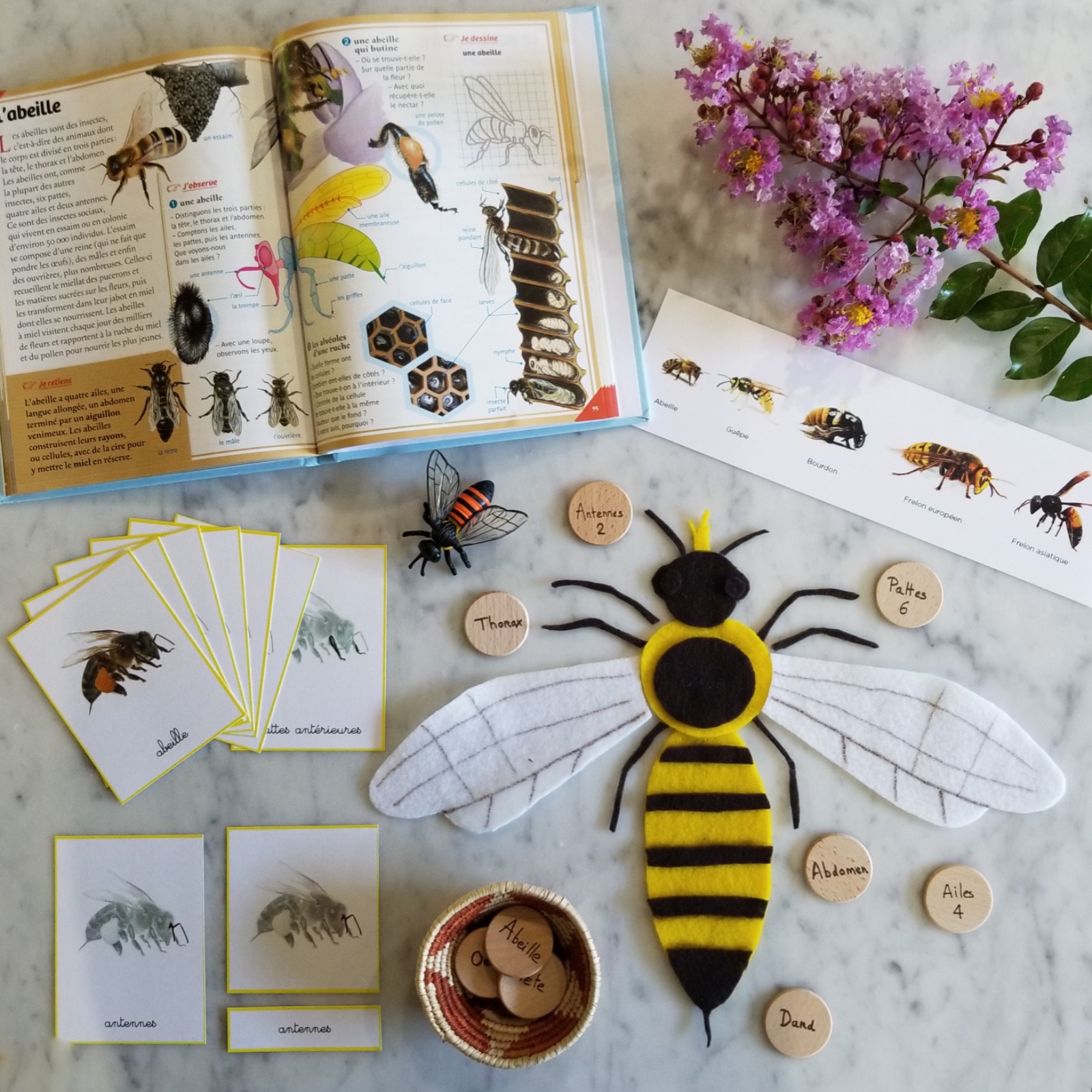Our bee study started when our dear 75 year old neighbor built a beehive and got a swarm of bees to move in! He showed it to the boys and since then Alex has been asking for "bees work".

Since I try my best to follow their interests, I obliged (plus I also find bees very interesting). Here is a summary of all the activities we did to learn more about bees!
We started with the bee anatomy puzzle. Since I did not have a puzzle I made one out of felt. I added French cards with body parts from Boutique Documents Montessori and we read “Petites leçons de choses” by Jean-Pierre Picandet. We also talked about the differences between bees, wasps, hornets... all the beautiful (and stinging) insects that live right out our front door.
I gave the boys the puzzle taken apart and they loved rebuilding it. It was clearly the highlight of this work.



We then worked on the life cycle of the bee. We have read quite a few books, but the French book about bees “Les Abeilles” by Imagerie Animale has an amazing life cycle. Then we used the Life Cycle of a Bee Safari TOOBs with more printouts from Boutique Documents Montessori.
We talked about the 3 different types of bees (queen, drones and workers) and how a worker bee lives only about 6 weeks and has many jobs during its life starting with housekeeping and nursing to finally becoming a field bee around 3 weeks old. The bottom print represents the life's work of a worker bee and each hexagon represents a day of a worker bees life (from Hatching Curiosity).
We also went to the children's museum (Chattanooga, TN) and visited the bee exhibit and the beehive that can be seen through the glass! This, as usual, was a huge favorite and a great way to see bees first hand.

Alex also asked why pollen is yellow. Since I didn't know we "Googled it" (to this day I still wonder when Google became a verb!!) and found out that although the predominant color not all plants produce yellow pollen; some produce orange pollen e.g. dandelion, others blue pollen, e.g. fuchsia, while some may produce pollen in various shades of red. Plant pollen tends to appear yellow because it contains flavonoids that are known to have protective properties against exposure from the sun. In addition, since insect pollinators such as bees, can't see red, plants produce yellow (or sometimes blue) pollen to attract them.
And oh irony! Right at the end of our bee study we had a water leak under the kitchen, so my husband goes under the house and pulls some wall boards and discovers a huge honeybees nest. We are now trying to get them relocated by a beekeeper. They need to take the queen out and the bees should follow. However we need to find the beekeeper who is willing to do that and see how that goes...

The small world is made entirely of natural materials (rocks, leaves, sticks, flowers...) and the bees are little bee erasers that are great as loose parts!

Permanent markers are a treat for the boys (although Matisse at 3 years old needs to be watched closely). Permanent markers look great with liquid watercolor and the round stampers made a nice beehive looking background. I also drew a step by step tutorial on how to draw a bee
Although, here is an important lesson: the sponge round is NOT a good idea with liquid watercolor, they put too much on it and then there is paint leaking everywhere!If you want a river though, it's the way to go! ;)

We made a cake and really enjoyed tasting it! We also read “Bees: A Honeyed History” by Piotr Socha which is a fantastic book about bees! It's a very complete book; in addition to the usual topics (anatomy, life cycle, organization...) it even includes some fun history, bee products, etc.
We also tasted different types of honey, learned that they are made from different flowers and investigated honeycombs.

with yellow, white and black playdough, bee cookie stamps (aren't they stunning?), little bee erasers, hexagons, beads and a few tools.
At first they carefully played with the stamps, then added yellow beads for pollen, then carefully added the bees... And then they got the knife and cut it all up and mix it all together, flattened it and had tons of fun with the mushed playdough!

With yellow rice as pollen, white pompoms as eggs and yellow/orange pompoms as honey! We used an ice cube tray as honeycomb cells and learned that typically the bottom part of the nest is reserved for the nursery, the middle part for the pollen and the top part for the honey.

